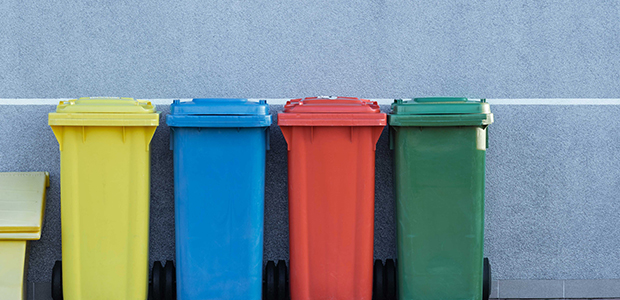
Which Plastics Are Recyclable and Which Aren’t?
It may seem as though you can finish with any plastic item and throw it into the recycling bin when you're done. Not so fast—surprisingly, not all plastics can be reused.
- By Jenna Tsui
- Jan 16, 2020
That fact sounds bad enough on its own, but it's even worse when you consider just how much of the material gets discarded. The mass production of plastic started about 60 years ago. In that time, manufacturers have created a stunning 8.3 billion metric tons of the stuff. Of that, 6.3 billion tons have become waste, clogging our oceans and landfills with a material that takes 400 years to break down.
Clearly, it's imperative that we start choosing plastics that can be recycled—and making the conscious choice to recycle every time. Here's everything you need to know about the process:
Which Plastics Can I Recycle? Why?
First, let's go over the six main categories into which you can sort your plastics. You've probably had all of these blends in your pantries and cupboards. They are:
- Polystyrene, or PS: You need polystyrene to make foam cups in which you can pour hot beverages. Plus, you'll find PS in yogurt containers and plastic cutlery.
- Low-density polyethylene, or LDPE: This material appears in plastic garbage bags, as well as in bins made of the material.
- Polypropylene, or PP: If you've discarded a takeout container, lunchbox or ice cream container, you've probably thrown away a bit of PP.
- Plasticised Polyvinyl chloride or polyvinyl chloride, or PVC: Any squeeze bottles or juice containers will have PVC in them.
- High-density polyethylene, or HDPE: It takes a bit of HDPE to form shampoo bottles and milk jugs.
- Polyethylene terephthalate, or PET: Your plastic soda and juice bottles have a bit of PET in them, most likely.
Shockingly, only the last three of these plastic groupings are currently recycled: PVC, HDPE and PET. The other three varieties tend to be thinner and flimsier. As such, they break down in the machinery and cause it to do the same. That's why lids and caps don't make it into the recycling facility, either. Plus, some plastics would be too dirty to reuse, thus forcing them into landfills or incinerators, too.
Of course, every city and town will have a different set of standards for this process. Check out your area's rules for recycling, and learn to read labels so you know everything that falls into the reusable category.
Can the Government Do Better?
You're probably surprised to hear that you can't recycle every single piece of plastic you buy—no wonder landfills are getting overcrowded. Some states have made strides toward better processes. For instance, in North Carolina, all plastic bottles sold must be recyclable. Considering Americans go through 2.5 million plastic bottles every hour, it seems like a good place to start.
Nowadays, technology is helping in the recycling process. When materials arrive at a recycling facility, staffers often have to manually sort through and quickly decide which items can and can't be reused. Now, though, there are devices meant to automatically sort through waste to find recyclables, and they can workday and night to do so. More efficient waste-sifting certainly keeps less unnecessary trash out of landfills, which is always a good thing.
Manufacturers have begun to search for new ways to use secondhand plastics, too. That way, fewer materials needlessly find their way to landfills. In the UK, for instance, experts have begun to use recycled PET plastics for thermoforming, in which they heat the material and turn it into something else.
There's still more to do, though. Namely, manufacturers have to start creating their products with their disposal in mind. Packaging and the product itself should be recyclable from now on. And governments will have to start setting aside the bottom line when it comes to recycling. Sure, some varieties aren't as economical to reuse, but tossing them into landfills or incinerating them does nothing for the environment.
Can I Do Better?
Upon reading all of this information, you might find yourself determined to recycle more now than ever. Indeed, a consciousness of what you discard will help clean up the planet, in the end. But the founder of the Zero Waste Lifestyle Movement, Bea Johnson, implores you to try something beyond that.
Johnson and her family of four create enough waste each year to fill a single jar, she said in a TED talk. She revealed that they do so by avoiding recycling—the process uses energy itself, she said. Plus, many recycled plastic products can't be reused a second time. Instead, she and her family avoid these materials altogether, and their waste output has shrunk to a shocking handful or so each year.
It might seem like a long road to reach a similar level, and it will be. But keep in mind that every stride you take along the way will help preserve the planet's resources and the environment itself. It's worth brushing up on your knowledge of what's recyclable, and what you can do to avoid wasting plastic altogether.
You can also use your voice: if enough people demand a lifestyle freer of waste than the one, they have now, then the government will respond. Remember, though, it starts with you.
About the Author
Jenna Tsui is a Texan journalist who co-owns The Byte Beat blog. She writes about the latest news in sustainability, culture, technology and more. Check out her work on TBB or follow her on Twitter @jenna_tsui .